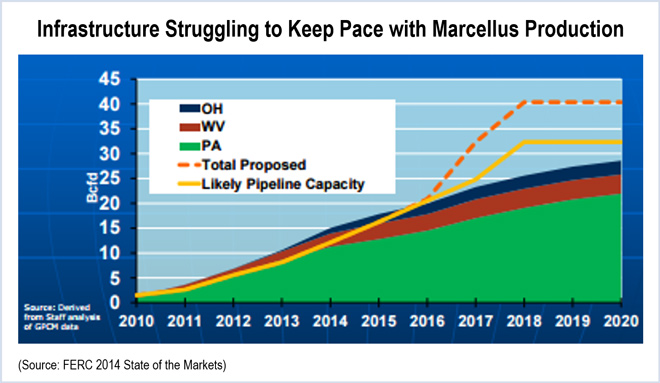By Rich Heidorn Jr.

Natural gas developments dominated FERC’s annual State of the Markets presentation in a year that also saw higher electric prices.
Demand and Production
The coldest winter in more than a decade helped push natural gas demand to a record 70.7 Bcf/d, with residential and commercial demand up 3% and industrial demand increasing 2%. The record came despite a cooler-than-normal summer, which resulted in a 3% decline in gas demand for electricity generation.
Natural gas production grew 5% to an average of 68.4 Bcf/d, breaking the previous record from 2013. The Marcellus shale formation in Pennsylvania and the Eagle Ford shale play in Texas were responsible for more than one-third of the production increase.
Despite the crash in crude oil prices — from $115 per barrel in mid-June to $53 at the end of December — natural gas production has remained above 71 Bcf/d in 2015, above levels for the same time last year.
Following last winter, the U.S. had only 822 Bcf of natural gas in storage, the lowest level since 2003. But a record injection totaling almost 2.8 Tcf — almost 10% above the previous high — returned storage levels to 3,611 Bcf by Nov. 1, only 5% less than the five-year average.
New Pipelines

The summer of 2014 resulted in several firsts, with the Northeast becoming a net gas exporter and New York and Boston recording gas prices below Henry Hub.
The commission said forward price curves indicate that natural gas, rather than coal, will be on the margin for the balance of 2015, as it was in 2012. That, commission staff said, could result in coal-fired generation displacing some gas generation this summer. “If oil prices remain at current levels, we could continue to see increased use of oil for power generation,” the commission added.
Gas and Renewables Continue to Displace Coal
The U.S. added 10.8 GW of electric generating capacity in 2014, after showing a net loss of 3 GW in 2013 due largely to coal and nuclear retirements.
Natural gas capacity rose by 7.7 GW, while wind capacity grew by 5 GW. Solar added almost 4 GW.
Financial Trading
RTOs increased their dominance of financial trading with 96% of electricity products traded outside ERCOT occurring at an RTO hub, up from 92% in 2013. Only NYISO and PJM saw increases in trading volumes for the year, with PJM increasing its market share to 73% of trading on Intercontinental Exchange, an increase from 68% in 2013.
Natural gas trading volumes on ICE dropped by more than one-quarter in 2014, the fourth decline in a row. “Less volatile prices hurt speculative trading profits; this caused companies, particularly large banks, to reduce or eliminate their trading exposure,” the commission said.
Electricity Prices
Despite essentially no increase in electricity demand, average spot prices rose across the country last year, largely due to high prices in the first quarter. The largest increase was in PJM, where average on-peak day-ahead prices at the Western Hub rose 38% to $63/MWh.


